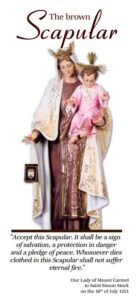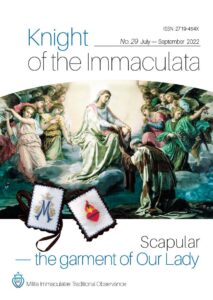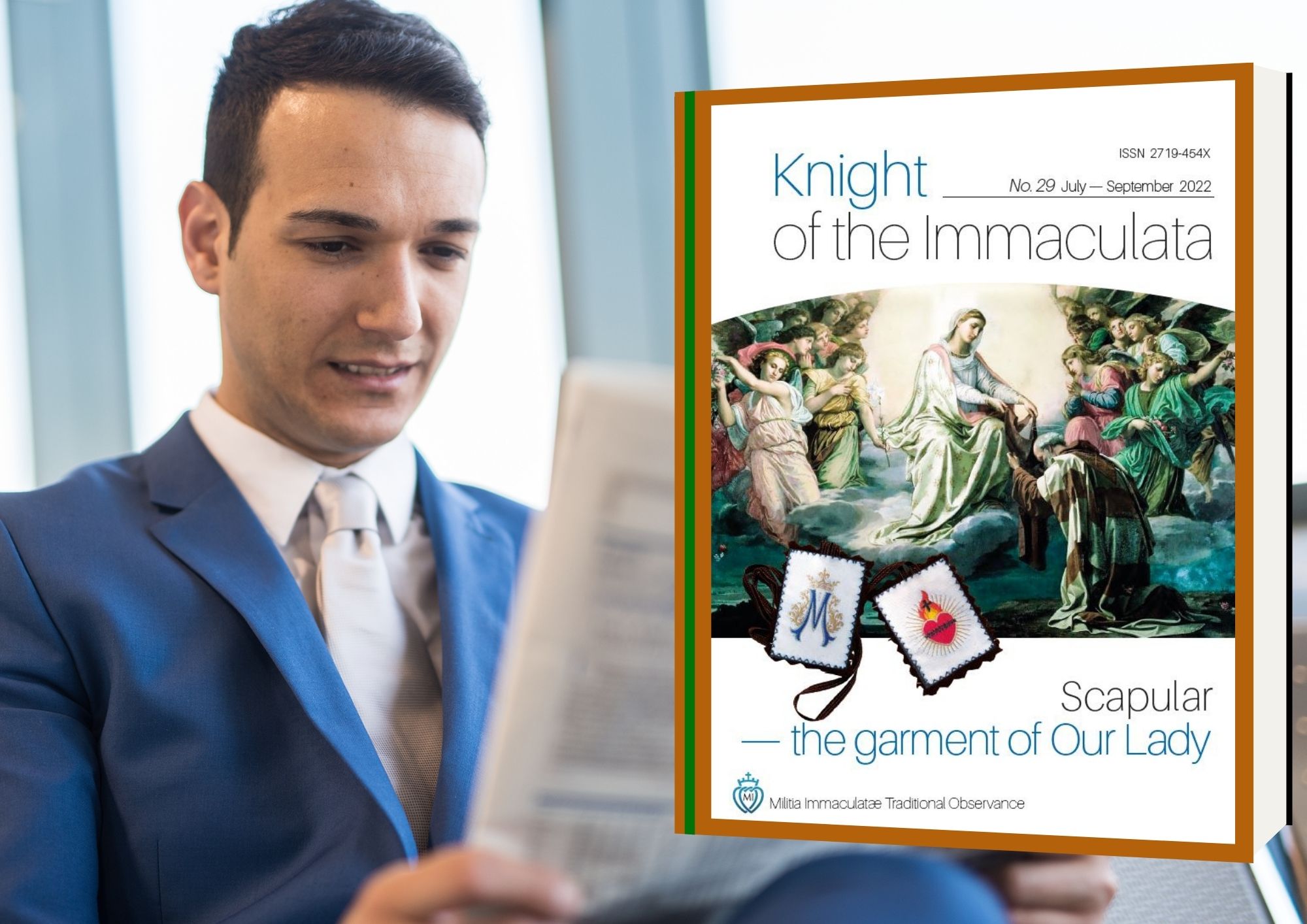Those who wear the Scapular have a special right to Our Lady’s assistance in life, at the moment of death and after death. Whoever wears the Carmelite Scapular is promised that their soul will be freed from Purgatory shortly after death. Provided, of course, that one not only wears the scapular, but that one wears it in the right spirit, in a truly Christian disposition, which manifests itself in a life according to the commandments of God. You can read about the conditions of wearing the scapular in our flyer: click on the picture
It is clear that a sacred garment intrinsically affecting a person, is much more adapted to designate the intimate character of Marian consecration, by which we, as children, offer ourselves to Mary entirely and forever, than a simple remembrance would be, like a statue, a medal or a distinctive secular livery which affect persons in a rather extrinsic manner. Moreover, the Scapular by reason of its history, which has made it for so long a universal means of intimate Marian devotion, is also a marvellous instrument of the Blessed Virgin’s singular protection, and for this reason too it is a distinctive reminder of consecration to her.
From the foregoing comes the importance of the Scapular. Consecration does not consist solely in a formula, but in that intimate sense of permanently pertaining to Mary and totally depending upon her. This intimate sense is perfectly symbolized by the Scapular which, worn continually, is a figure of the sweet and light yoke of Christ, and is as a shield in all dangers, especially on the day of death. By recalling constantly the remembrance of Mary, the Scapular nourishes our sense of belonging to her; it makes us realize that our close alliance with her keeps us always under her protection.
The Scapular encourages Marian consecration so much more in that it shows to all most concretely and clearly, by means of Mary’s great promises, the real devotion to her. In fact these promises, doctrinally speaking, are only the practical application of those famous principles: that no one devoted to Mary shall be eternally lost, and that devotion to Mary is a sign of salvation.
Certainly, by showing this value in a concrete manner, the Scapular develops in us the greatest confidence in Mary who takes such tender care of her devoted ones, and who is so powerful that those who rely on her patronage can have a firm and unlimited hope of obtaining eternal salvation. It is true that theological hope does not exclude the fear which arises from the weakness of human nature; nevertheless this fear is more than compensated for by consideration of the supernatural motive of the salvation, which, in this case, is the power and mercy and fidelity of the Blessed Virgin. By means of the Scapular we become so intimately united to Mary that she becomes our only Patroness and Lady, our Mother and Queen.
When we are made part of Mary’s family, placed under her protection, we should not worry about obtaining the various privileges made known by St. Simon Stock who invoked her as the Flower of Carmel; we should simply seek that we may constantly persevere in her service, clothed until death in her garment. The promises of the Scapular, for the hour of death and for purgatory, are a splendid application of that universal mediation of Our Lady, and our faith in that mediation is greatly increased by our devotion. In reality, together with the Rosary, there is no other form of Marian devotion which has been found to be so perfect, as that of the Scapular. It is evident, therefore, that the Scapular can play an important part in restoring the Christian spirit.
The Scapular then seems to answer in a practical way the present day need of expressing with a definite, permanent sign the consecration of the human race and of each one of us to the Immaculate Heart of Mary, so that, this consecration being always present with us, the Blessed Virgin may be for us that Star of the Sea which, through the storms of this life, brings us happily to the port of eternal salvation towards which we tend.
I encourage you all to receive the scapular and wear it faithfully.
Fr. Karl Stehlin
Warsaw, on the 2nd of July, the Visitation of the Blessed Virgin Mary



